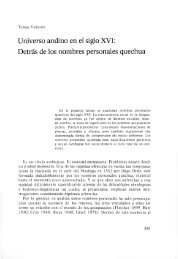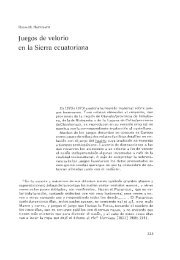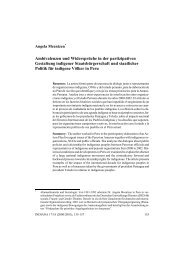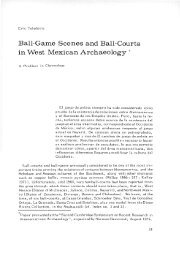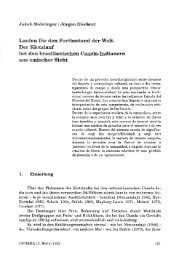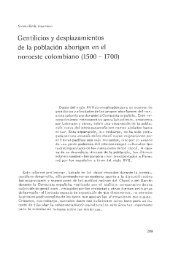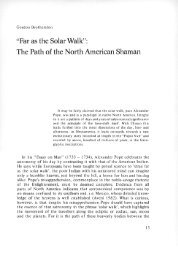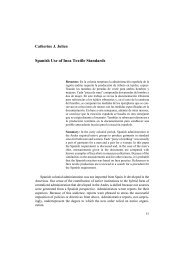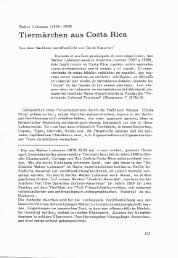Time and Script in Ancient Mesoamerica
Time and Script in Ancient Mesoamerica
Time and Script in Ancient Mesoamerica
You also want an ePaper? Increase the reach of your titles
YUMPU automatically turns print PDFs into web optimized ePapers that Google loves.
nomical time (with a new year <strong>in</strong>, say, March or December) via the adjustments<br />
proper to the 365 'days' of the Calendar Round year, so that local agriculture<br />
<strong>and</strong> religion did not 'slip' <strong>in</strong> relation to local seasons. As we shall<br />
see below, th<strong>in</strong>gs were different <strong>in</strong> the Long Count system, where the need<br />
for arithmetical consistency, of day units, led to an effective disregard of<br />
the seasons of the solar year. Where this system was not used, however,<br />
adjustment seems, not even to have been considered a problem.<br />
Victor M. Castillo (1971) has recently compiled evidence on these matters<br />
from a wide variety of sources. His ma<strong>in</strong> argument, superbly developed,<br />
shows how certa<strong>in</strong> pr<strong>in</strong>ciples operate amongst a mass of <strong>in</strong>tricate <strong>and</strong> confus<strong>in</strong>g<br />
material. His ma<strong>in</strong> example from the pre-Conquest period is the Aztecs.<br />
They made of every fourth year someth<strong>in</strong>g like a leap year by extend<strong>in</strong>g<br />
the limits of a 'day' <strong>in</strong> the second festival of the month Izcalli. which as<br />
a result ran <strong>in</strong>to the period of five vague'unnamed' days called nemontemi .<br />
the ceremonial <strong>and</strong> agricultural months thus keep<strong>in</strong>g <strong>in</strong> step with the Calendar<br />
Round <strong>and</strong> the number 365. To have a birthday dur<strong>in</strong>g this astronomically<br />
<strong>in</strong>constant time was considered a dangerous fate, <strong>and</strong> dur<strong>in</strong>g the Izcalli<br />
festivalevervonewas required to be drunk, even children, so that abnormalities<br />
<strong>in</strong> the limits of the day should not be unduly noticed. For us the<br />
important th<strong>in</strong>g is clearly that a day could at all be def<strong>in</strong>ed as anyth<strong>in</strong>g but<br />
more or less 24 hours. Dur<strong>in</strong>g the fire-drill<strong>in</strong>g ceremonies which accompanied<br />
the start of a new Calendar Round, an additional <strong>and</strong> special adjustment<br />
was made by read<strong>in</strong>g the movement of the constellation mamalhuaztli.<br />
so that over milennia 'seasonal' discrepancy would have developed because<br />
of effective reliance on sidereal rather than solar time (the difference between<br />
the two aris<strong>in</strong>g from precession). The Aztec empire did not last long<br />
enough for such a discrepancy to become noticeable, <strong>and</strong> too little is known<br />
about other non-Long Count civilizations prior to the conquest to say how it<br />
might have been dealt with had it become apparent as a result of practices<br />
similar to the Aztecs'. Information on the practice of modern Indians still<br />
us<strong>in</strong>g a pre-European calendar (Castillo 1971; Villa Rojas 1968; Berl<strong>in</strong> 1967;<br />
Gossen 1974) suggest that nowadays a date <strong>in</strong> the Christian calendar may provide<br />
the same k<strong>in</strong>d of ad hoc annual term, logically <strong>and</strong> systematically of no<br />
consequence, as was <strong>and</strong> is otherwise provided by a sunrise position or some<br />
similar phenomenon.<br />
The non-def<strong>in</strong>itive relationship of the parts of the calendar to equal divisions<br />
of astronomical time, <strong>and</strong> the logical prevalence of the former, is constantly<br />
affirmed <strong>in</strong> the pre-Conquest codices. A good example is aga<strong>in</strong> page<br />
one of the Fejérváry (fig. 1), with its year bearers symmetrical to anatomy<br />
<strong>and</strong> groups of the twenty signs, unqualified temporally or even numerically.<br />
Yet more <strong>in</strong>terest<strong>in</strong>g are the cases where the logic of the calendar is less<br />
apparent from spatial pattern<strong>in</strong>g alone. The 52 pages of the obverse of the<br />
Vienna Codex deal with ten ritual fire-drill<strong>in</strong>gs, which among the Aztecs accompanied<br />
the start of a new Calendar Round. The section devoted to each<br />
may be 'read', right to left, along a boustrophedon course, from preparatory<br />
beg<strong>in</strong>n<strong>in</strong>gs to the culm<strong>in</strong>at<strong>in</strong>g ritual act. And along some of the course<br />
16





